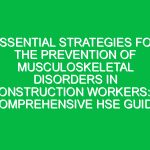In the rapidly evolving construction landscape, modular and prefabricated construction methods are gaining significant traction. These innovative approaches not only offer efficiency and cost-effectiveness but also pose unique challenges in the realm of Health, Safety, and Environment (HSE). As we step into 2023, it’s crucial to stay ahead of the curve by implementing essential HSE guidelines tailored for modular and prefabricated construction. This article aims to shed light on these guidelines, ensuring a safer, more sustainable construction environment for all stakeholders involved.
Understanding the HSE Implications in Modular and Prefabricated Construction
Before diving into the guidelines, it’s essential to grasp the unique HSE implications associated with modular and prefabricated construction. Unlike traditional construction methods, these techniques involve significant off-site manufacturing, which shifts some safety risks from the construction site to the factory. However, this doesn’t eliminate on-site risks but rather introduces new challenges that require innovative solutions.
The Importance of HSE in Modern Construction Practices
Health, Safety, and Environment (HSE) management is more than a regulatory requirement; it’s a cornerstone of sustainable and responsible construction practices. In the context of modular and prefabricated construction, HSE management plays a pivotal role in protecting workers, the community, and the environment, while also enhancing productivity and reducing costs.
Essential HSE Guidelines for Modular and Prefabricated Construction in 2023
As we navigate the complexities of modern construction, adhering to the following HSE guidelines will be instrumental in maximizing safety and sustainability.
Comprehensive Planning and Risk Assessment
Effective HSE management begins with thorough planning and risk assessment. For modular and prefabricated construction, this involves identifying potential hazards associated with off-site manufacturing and on-site assembly, and devising strategies to mitigate these risks. Emphasizing early engagement of HSE professionals in the planning process can significantly enhance the safety outcomes.
Enhanced Worker Training and Education
Given the unique challenges of modular and prefabricated construction, providing workers with specialized training is crucial. This includes education on safe handling and assembly of prefabricated components, as well as training on new technologies and equipment used in the manufacturing process. A well-informed workforce is a fundamental pillar of a safe construction environment.
Implementing Strict Quality Control Measures
Quality control is paramount in modular and prefabricated construction, as defects in manufactured components can pose significant safety risks. Implementing rigorous quality control protocols in the factory setting, along with regular inspections and testing, can prevent the occurrence of safety incidents related to component failure.
Adopting Advanced Technologies for Safety Management
The integration of advanced technologies, such as Building Information Modeling (BIM), can revolutionize HSE management in modular and prefabricated construction. BIM allows for detailed visualization and analysis of the construction process, facilitating better planning, coordination, and risk management. Additionally, the use of drones and wearable technology can enhance on-site safety monitoring and incident prevention.
Ensuring Environmental Sustainability
Modular and prefabricated construction offers significant environmental benefits, including reduced waste and lower carbon emissions. To maximize these benefits, it’s essential to adopt sustainable materials and practices throughout the construction process. This includes responsible sourcing of materials, efficient waste management, and minimizing energy consumption in the manufacturing and assembly phases.
Overcoming Challenges to Implement HSE Guidelines
While the benefits of adhering to these HSE guidelines are clear, implementing them can present challenges. These may include resistance to change, the need for investment in training and technology, and the complexity of coordinating HSE management across different locations. Overcoming these challenges requires strong leadership, a culture of safety, and a commitment to continuous improvement.
Building a Culture of Safety and Responsibility
Creating a culture that prioritizes safety and environmental responsibility is essential for the successful implementation of HSE guidelines. This involves leadership commitment, open communication, and fostering a sense of collective responsibility among all stakeholders. Recognizing and rewarding safe practices can also motivate adherence to HSE standards.
Conclusion: The Path Forward for Safety in Modular and Prefabricated Construction
As modular and prefabricated construction continues to grow in popularity, the importance of robust HSE management cannot be overstated. By embracing the essential HSE guidelines outlined in this article, construction professionals can ensure safer, more sustainable projects in 2023 and beyond. Comprehensive planning, enhanced worker training, strict quality control, advanced technologies, and a commitment to environmental sustainability are key to maximizing safety in this innovative construction sector.
Ultimately, the path forward requires a collective effort from all stakeholders to overcome challenges and build a culture of safety and responsibility. By doing so, we can unlock the full potential of modular and prefabricated construction, delivering projects that are not only efficient and cost-effective but also safe and sustainable for generations to come.
Summary of Key Points
- Understanding the unique HSE implications of modular and prefabricated construction is crucial for effective safety management.
- Comprehensive planning and risk assessment, enhanced worker training, and strict quality control measures are essential for maximizing safety.
- Adopting advanced technologies and ensuring environmental sustainability can significantly improve HSE outcomes.
- Overcoming implementation challenges requires a culture of safety, leadership commitment, and continuous improvement.
- By adhering to these guidelines, the construction industry can achieve safer, more sustainable modular and prefabricated projects in 2023 and beyond.


